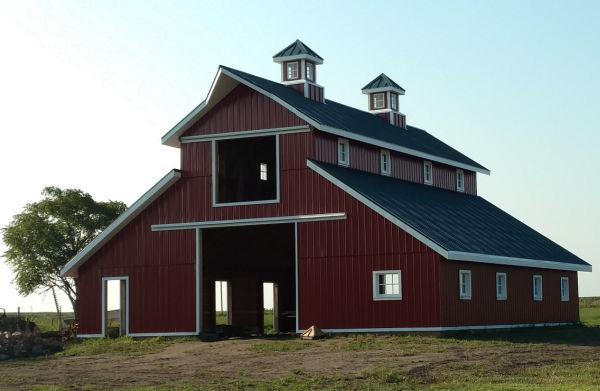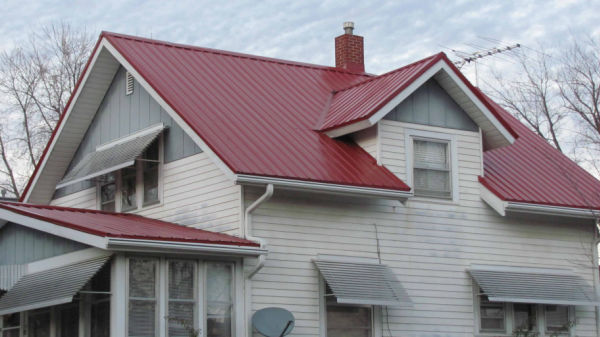Yes. Metal roofing can usually be installed over asphalt or fiberglass roofing. Metal is lightweight and allows for more options over an old roof without tear-off. It’s very common for metal roofs to be installed on top of shingles. This saves on labor and disposal fees for taking off the old roof, not to mention reducing landfill waste.
Gauge is a measure of the thickness of metal. 29ga is most common for pole barns. Another gauge option is 26ga, which can allow for more protection on wall sheets and a further span on roof sheets.
Metal is one of the most common, trusted materials for barn building. The reasons for this include:
- Quick and easy to install
- Strong against harsh elements
- Inexpensive relative to other materials
- Minimal maintenance
- Available in a wide variety of colors
29ga is rated to span 2 feet on the roof, and 3 feet on the walls. 26ga allows for a 4-foot span on both the roof and walls.
You will need to run a stringer between them to use a 29ga panel. Four feet is the maximum you want to span a 3/4″ rib panel. The 26ga PBR panel will span the 8 feet. The 1-1/4″ raised ribs and heavier gauge make for a stronger, more durable panel.
No. In general, the color will be white but is not warranted to be consistent. If this is of concern to you, we can produce your order from the same coil.
You do not need to pre-drill. Today’s screws self-tap through the metal and have a neoprene washer to correctly seal the metal. You can pre-drill for aesthetic reasons but be sure to line up where you will hit the wood board.
The initial cost may be higher but the life cycle costs of metal roofing are substantially lower than other forms of roofing. Metal roofing does not break down under repeated wet/dry and freeze/thaw cycles. Most homeowners can’t afford to replace their conventional roof every 8 to 12 years. A metal roof will never decompose.
Metal roofing does not attract lightning and poses no additional risk of being hit by lightning than any other type of roof. If your roof is struck, a metal roof can actually prevent damage by dissipating the electrical charge. A metal roof is non-combustible.
Metal roofing is usually installed over an existing roof or solid decking with an insulating barrier. Metal roofing over solid decking will generate no more noise than other roofing materials.
Metal roofing products meet Underwriting Laboratories UL 2218 Impact Resistance Testing at Class IV. Hail damage on a metal roof is often cosmetic and does not affect the integrity of the roof. Often if dents do occur and are small, a hot summer day may cause them to lessen or disappear.
Metal roofing has been tested to withstand winds up to 120mph. If properly installed a meal roof can withstand harsh storms.
Metal roofs are fire-resistant. Blown on embers will not cause combustion. Metal roofs almost always have a calls “A” rating because metal is non-combustible.
Most metal roof panels are corrugated giving greater strength to handle occasional roof traffic. A residential roof installed over solid decking can be walked on without damage. Avoid stepping on the ribs or the ridge cap. Metal roofs require virtually no maintenance so you shouldn’t be on your roof often.
Metal reflects some 70% of the sun’s energy. Asphalt or composite roofs absorb heat from the sun. A properly installed roof can reflect and dissipate heat quickly. The more solar energy reflected the less energy is required to cool it.
Metal is one of the longest-lasting roof materials you can buy. Advanced treatments to the base metal prevent rust for years. Multilayer paint technologies allow for warranties up to 40 years. Killian’s Custom Metal Roofing & Panel uses Sherwin Williams WeatherXL™ on all of our warranted colors. With proper maintenance, you should get decades out of your metal roof.
Yes. Metal is great for the environment. Most metal coils used for roofing contain at least 25% recycled material. According to the National Association of Homebuilders Research Center, 20 billion pounds of asphalt shingles are dumped in U.S. landfills every year. Most metal roofs can be installed over the current roof without tearing off and contributing to landfills. The metal used for roofing is clean, and 100% recyclable.
Yes, it is possible to qualify for insurance discounts. The most common discount is in regards to the hail/impact resistant rating. Some insurers may require you to sign a waiver releasing them from aesthetic claims. Keep in mind that this waiver means your roof could sustain unsightly dents but if it is not leaking or compromised they will not replace it. There are many possibilities for insurance discounts and it is best to call your insurance agent.
Metal roofing is available in many styles and colors and has exceptional durability. It sheds ice and water in the winter. Metal roofing does not absorb or get damaged by water and is environmentally friendly.






